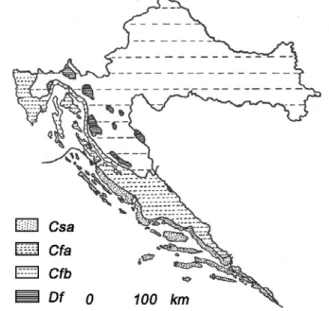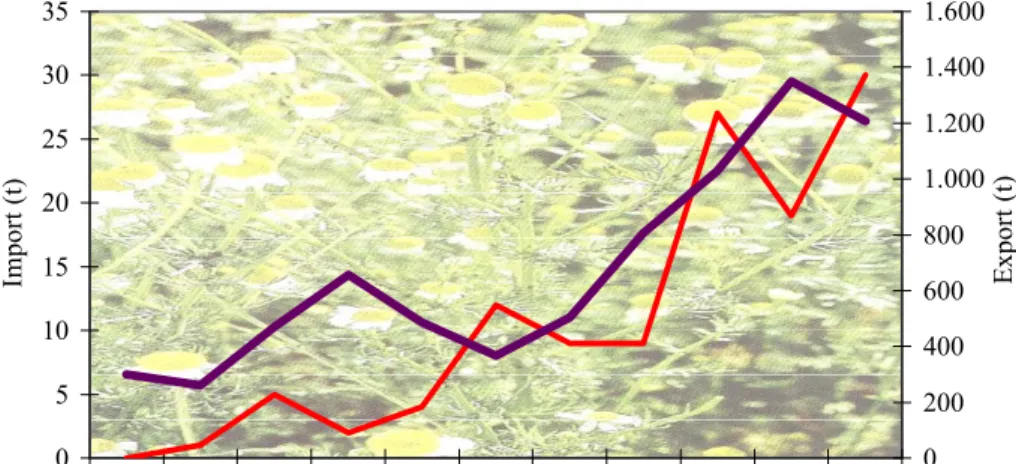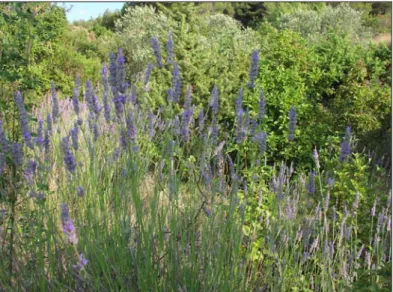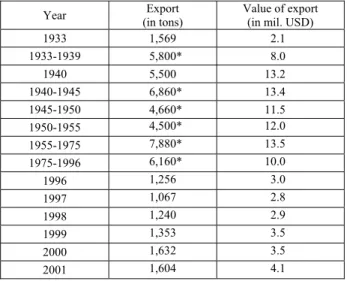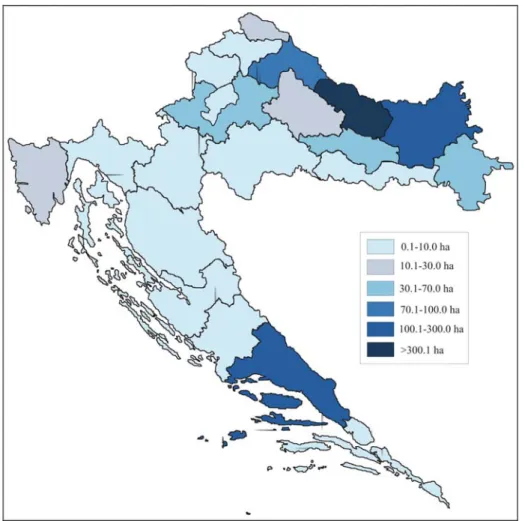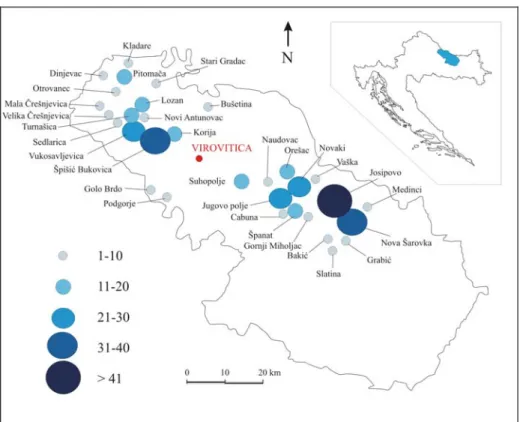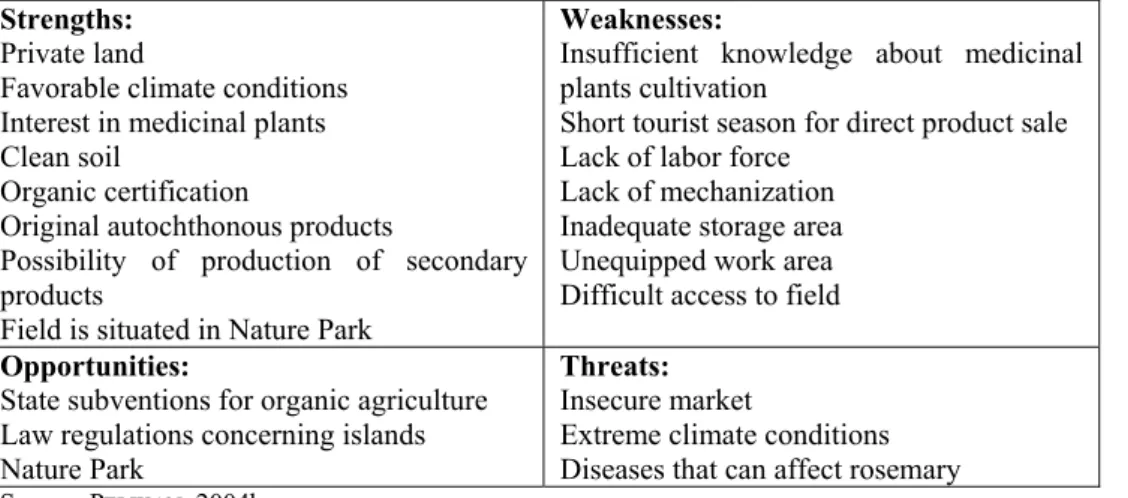GEOGRAPHIC ASPECTS OF MEDICINAL PLANTS
ORGANIC GROWING IN CROATIA
ŽELJKA ŠILJKOVIĆ UDC: 911.3:633.88](497.5)
ANA RIMANIĆ Original scientific paper
Department of Geography, University of Zadar Izvorni znanstveni članak Odjel za geografiju, Sveučilište u Zadru
Received: 2005-05-13 Primljeno:
There are about 160 to 170 autochthonous medicinal and aromatic plants that are either collected or produced in Croatia. In all parts of Croatia natural geographic conditions, namely climatic, pedological and hydrographical conditions are suitable for organic production of medicinal plants. In this work the authors give the most relevant information on chamomile (Matricaria chamomile) and lavender (Lavandula anustifolia) production. These two plants had the biggest share in medicinal plants production before war in the 1990s. Until then Croatia was one of the leading producers of chamomile and lavender in the world.
The article deals with the current situation of collecting and producing medicinal plants in Croatia and the opportunities that economic activity can offer. The main goal is to determine natural geographic conditions which influence organic medicinal plants production that contribute to the revitalization of rural areas and slow down deagrarization and deruralisation if systematically applied.
Key words: medicinal plants, organic production, natural-geographic conditions, chamomile, lavender
U Hrvatskoj se prikuplja i uzgaja između 160 i 170 autohtonih, ljekovitih i aromatičnih biljnih vrsta. Prirodno geografski uvjeti, posebice klimatski, pedološki i hidrografski, iznimno su povoljni za ekološki uzgoj ljekovitog bilja u svim dijelovima Republike Hrvatske. U radu je posebno opisan uzgoj kamilice (Matricaria chamomilae) i lavande (Lavandula anustifolia) kao dviju biljaka koje su do prije Domovinskog rata činile najveći udio uzgoja ljekovitog bilja u Hrvatskoj koja je bila jedna od vodećih svjetskih proizvođača kamilice i lavande.
U članku je analizirano trenutno stanje uzgoja ljekovitog bilja u Hrvatskoj te mogućnosti koje nudi taj dosad neiskorišten gospodarski sektor. Glavni je cilj istaknuti prirodno-geografske uvjete koji utječu na ekološku proizvodnju ljekovitog bilja koja, ukoliko se provede sustavno, može pridonijeti revitalizaciji ruralnih prostora te usporiti procese deagrarizacije i deruralizacije.
Ključne riječi: ljekovito bilje, ekološka proizvodnja, prirodno-geografski uvjeti, kamilica, lavanda
Introduction
One of the basic characteristics of Croatian flora is an abundance of medicinal plants. According to definition, medicinal plants are all herbal species and cultivars whose one or more parts have biologically active substance that can be used for therapy or for pharmaceutical-chemical analyses (PAHLOW, 1989). Out of 35,000 herbal species
on Earth 12,000 of them are used for medical purposes (ŠILJEŠ ET AL., 1997). Medicinal
plants provide accessible and culturally relevant sources of primary health care to almost two thirds of human population. They are a unique type of natural product requiring special considerations due to their impact on people's health (MARTINIĆ,2003). In Croatia there are more than 600 wild medicinal, aromatic and honey plant species, 120 of which are traditionally used in folk medicine, as food, for bee grazing (honey and other honey products), production of powder, juices, elixirs, tinctures, oils, wines, etc. (KOLAK ET AL., 2002).
The main reason of Croatian flora complexity is its geographical position. During Pleistocene Dinaric Mountains areas were out of the influence of glaciations, which were restricted only to the mountainous part with average height of above 1,600 m. As a consequence of such settings, the old Tertiary flora survived, which was not the case in other parts of Europe where it became extinct or significantly threatened. Due to the spreading or withdrawal of glaciers Dinaric Mountains area was enriched by elements of Alpine, boreal, Mediterranean, Atlantic and other floras (ŠUGAR, 1998).
Organic agriculture represents a system of economic activities that strives to achieve ethical, ecological, socially equitable and economically profitable agricultural production (ZNAOR, 2001.) Farmers who decide to accept this holistic approach to
agriculture must also accept the state laws concerning protection of soil, water, air and biological diversity. IFOAM is an independent, global, non-profit organization founded in 1972, consisting of more than 700 member organizations; farmers' groups and cooperatives, processors, trade firms, scientific organizations, consulting firms and certifiers in more than 100 countries worldwide (URL 1). It is an umbrella organization whose mission is to help, direct and unite all those who want to adopt ecologically, socially and economically sound systems that are based on the Principles of Organic Agriculture. Next year the 1st IFOAM Conference on Organic Wild Production will be held in Bosnia and Herzegovina concerning trade in "organic" wild products such as berries, mushrooms and a wide variety of herbs. Information about herbal sector is vague and there are not many statistical data, which created a problem for the authors in writing this article.
Organic agriculture is based on assumptions of sustainable development whose grounds were set by European Commission for Environment and Development in 1987. Sustainable development encompasses the idea that we can use natural resources up to a point when we start causing disturbance in natural ecosystems that need to be saved for future generations. Taking into consideration the fact that medicinal plants have active substances that can easily take on harmful compounds from the environment, the production of highly qualitative medicinal plants is possible only by organic production (PELIKAN, 2004a). Although undeveloped, organic production of medicinal plants in
Croatia is possible and it should be encouraged.
During the last decade, the production of medicinal plants in Croatia has shown a tendency of constant increase. Considering natural conditions we can say that there are no
areas where the production could not be an important economic activity if the cultivar is carefully selected (KOLAK ET AL., 1997a). There is an ongoing trend in the world to pass
laws regarding production and restrictions of uncontrolled harvesting in order to stop eventual extinction of certain plant species (BRUL, 2000). Organic cultivation of medicinal plants should be encouraged in the same way as organic olive cultivation, not only because of its positive effects on human health but also because of the development of Croatia's most important economic sector – tourism (ČUKA, 2002).
Natural geographic conditions of organic cultivation of medicinal plants
All forms of agricultural production: conventional, integrated, organic and biologically-dynamic depend on natural geographic conditions of the area they are applied to. Exterior influences on plants can be divided into four major groups: meteorological (refer to all changes occurring in the atmosphere), 2. geomorphological (refer to outer form of the soil; its inclination, exposition, orientation), 3. edaphic (refer to characteristics of soil; its structure, share of humus and organic substances and their chemical characteristics) and 4. biotic (refer to the influence of living organisms on plant growth) (PENZAR, PENZAR,2000). Croatia is situated in the North Temperate Zone hence
its geographical latitude influences synthesis of acid oily substances in medicinal and aromatic plants (KOLAK ET AL.,1997).There is hardly a branch of human activities that is as dependent on weather as agriculture.
Fig. 1 Climate regionalization of Croatia (according to Köppen, modified after ŠEGOTA, 1996)
Sl. 2. Klimatska regionalizacija Hrvatske (prema Köppenu, izmjenjeno prema ŠEGOTA, 1996.)
Climate has a major influence on cultivation of all plants. According toKöppen's climate classification Croatia is dominated by climate type C and its three subtypes: Cfa, Cfb and Csa (Fig. 1). The Adriatic coast south of Lošinj and west of Pag has Csa climate or "the climate of olive". The average July temperature is ≥ 22 ºC, while the average January temperature varies from 5 ºC to 9 ºC. In the largest part of Croatia Cf climate prevails. Its main characteristic is even distribution of precipitation throughout the year. Quarner Littoral, the Islands of Krk, Rab, Pag, Cres, Lošinj and hinterland of Central Dalmatia have this type of climate. Mountainous Croatia and Istrian inland, Pannonian and Peripannonian Croatia have Cfb climate or "the climate of the beech". The highest parts of Mountainous Croatia have a humid boreal climate (ŠEGOTA, FILIPČIĆ, 1996). This variety of climate types is one of the principal advantages of Croatia in view of medicinal plants cultivation on its territory.
Primary agro ecological conditions concerning the cultivation of medicinal plants are temperature and light, while secondary include precipitation, wind, soil, insects, isolation, etc. (KOLAK ET AL.,1997b).Chamomile can be cultivated in the areas with Cfb
climate, which as it has been mentioned before, dominates in Pannonian and Peripannonian part of Croatia. Therefore, this is the area with the highest share of land under chamomile. Depending on climate conditions it can be sowed at different times throughout the year. In the case of autumn temperatures above the average, it can be sawed even at the beginning of November. It springs up and grows starting from 6 ºC, but its optimal temperature for growth and development is from 20 ºC to 25 ºC. In the case when daily temperatures are below 20 ºC, the herb quality is reduced. In 1989, during flowering of chamomile, daily temperatures varied for 15 days from 8 ºC to 17 ºC causing the decrease of etheric oil to only 0.5 per cent (ŠILJEŠ ET AL., 1992). In order for
chamomile to spring up, it needs a lot of sunlight. Frequent spring temperature oscillations can reflect negatively on chamomile quality, as it was the case in 2005 (URL 2).
Lavender prefers a temperate climate, Csa type, so it is present in Mediterranean countries (WILLFORT, 2002). Csa climate has three major characteristic: scarce annual precipitation in winter and almost rainless summers; great difference between summer and winter temperatures (winter temperatures are mild and summer vary from hot to warm), clear skies and a lot of sunshine, particularly in summer.
Lavender flowers from July to August when the Mediterranean area is characterized by highest temperatures. If it is grown out of its natural habitat, it loses a great deal of its original scent. For example, lavender grown on Mljet has more linoleum acid than lavender grown in Zagreb or Osijek (KOLAK ET AL.,1997). Lavender is a
thermophile plant that requires a lot of sunlight (BREMNESS,1995). Those conditions are completely fulfilled in the whole Littoral Croatia. In the period from 1961 to 1990, an average of 2,711 hours of sun and 130 sunny days per annum were recorded on Hvar (ŠEGOTA,1996). Those climate conditions are ideal for the cultivation of lavender. Lower
temperature can cause delays in flowering of the plant from 10 to 15 days (KOLAK, ŠATOVIĆ, 2003). Lavender can also be cultivated in areas with lower average temperatures since during crypto vegetation it can endure low temperatures between -10 ºC and -20 ºC, but in such conditions the quality of its oil is significantly reduced.
Chamomile prefers more humid areas to arid ones (Eastern Slavonia-Podravina) because water stimulates the creation of flower and seed. This does not imply that the cultivation of chamomile in Podravina is impossible, but the success of the harvesting
will depend on the amount of annual precipitation. In 2003 precipitation in May was from 10 to 15 l/m2 and as a consequence there was 80 per cent less crop than expected (URL 3). On the other hand, lavender prefers more arid areas and it can survive during a long arid period in warm and hot summer months when it is in its vegetational period. Moreover, it rationally uses water in dry and hot summer months and during the periods with higher precipitation rates it looses a certain amount of etheric oils.
Composition of soil is very important for the growth of every plant. Chamomile is mostly cultivated in Pannonian-Peripannonian part of Croatia and it is cultivated on soils on which other plants have difficulty ingrowing. It grows on loess, brown soils, hypogley and pseudogley. The only type of soil where it cannot grow is limestone (KOLAK, 1997). The similar situation is with lavender, which can be cultivated even on
the poorest organic soils. Regardless of its ability to adapt easily to natural conditions, lavender cannot grow on cold, swampy and flooded soils. As a wild plant, lavender can be found on arid and karst Mediterranean slopes (BONACCI,2002).Its adjustment to karst
and waterless areas of Dalmatia is a consequence of lavender's woody and well developed root which can breakthrough up to the depth of 200 cm (KOLAK ET AL., 2003). When
cultivated, lavender prefers protected and sunny slopes (WILLFORT, 2002). Lavender cultivated on higher elevations has better oil quality than the lavender cultivated on lower elevations. It can often be found on steep slopes where it prevents the process of erosion.
Cultivation of medicinal herbs in Croatia on the example of lavender and chamomile
Chamomile is a plant whose medicinal characteristics were well-known to the ancient Egyptians, who used it as a medicine to cure fever. It is an annual plant of the sunflower family Asteraceae (TOPLAK,2001). It originated in Asia, and today is a
world-wide spread plant. Farmers have always found it in their fields where it grows as a weed they can fight against only with herbicides. Organized cultivation of chamomile in the world has an over 40-year-old tradition. Year 1988, when over 600 acres of chamomile were sawed, is considered to be the milestone of organized chamomile cultivation in Croatia (ŠILJEŠ ET AL., 1992). Over the past few years, the cultivation of chamomile has
spread to almost the entire Pannonian-Peripannonian part of Croatia.
Cultivation of chamomile is much more economically profitable than the cultivation of other agricultural crops. Most chamomile producers have an additional activity, since the activities connected to chamomile harvesting last about 10 to14 days. Saving on machinery presents an additional decrease in chamomile cultivation costs. Most producers use a special fertilizer for sowing chamomile instead of buying a sower for small-seeded plants. The problem occurs during the harvest which can be conducted only by using a chamomile harvester. Figure 2 shows a constant trend of chamomile export growth, especially in the period after 1998, since an increasing number of farmers decided to cultivate chamomile because of economic reasons.
Lavender is a plant that originated in the Mediterranean region and it is cultivated in most Mediterranean countries. It is used in everyday life as a spice in cooking, as well as in many cosmetic and medicinal products. Lavender is also a frequent horticultural ornament of most Dalmatian gardens. The centres of lavender production in Croatia are Grablje and Brusje on Hvar Island (KUŠTRAK, 1998). About 60 to 80 tons of
abovementioned natural geographic factors influence the successful production of lavender, which was brought to the island from France via Dubrovnik. It was first covertly cultivated during 1920's, and today it covers about 700 acres on Hvar Island (BONACCI, 2002). 0 5 10 15 20 25 30 35 1991. 1992. 1993. 1994. 1995. 1996. 1997. 1998. 1999. 2000. 2001. Years Imp ort (t) 0 200 400 600 800 1.000 1.200 1.400 1.600 E xpo rt ( t) Import Export Fig. 2 Import and export of chamomile in the period from 1991 to 2001
Sl. 2. Uvoz i izvoz kamilice u razdoblju od 1991. do 2001. Source: CROATIAN BUREAU OF STATISTICS, 2005
Lavender was more intensively cultivated between the two world wars when it replaced vine destroyed by peronospora. Mass production started after WWII, when a large number of inhabitants of Hvar Island cleared their vineyards to plant lavender because of the simplicity of its cultivation and low investments. A small decrease in its cultivation occurred in 1970's when the market price of lavender dropped. Because of a low market price, long droughts and fires, the inhabitants partly returned to vine cultivation. During 1980's, and especially during the Homeland War, demands for the lavender oil, made from a low-quality hybrid REV I, which was sowed on about 600 acres of the island, dropped rapidly. Before the 1990's Serbia bought most of lavender oil, but after the Homeland War market relations were disrupted, which caused stock building of lavender oil in the amount of over 20,000 kg (AGRICULTURAL ASSOCIATION OF HVAR, 2005).
To stop this process and initiate the cultivation of lavender again the Agricultural Association of Hvar started a project in 1998 with the goal of creating a raw material basis for the production of quality ethericoil, which would be competitive on the market. In the period between 1999 and 2001 the cooperants on Hvar were supplied with about 150,000 seedlings, while about 60,000 seedlings were sent to other parts of Littoral Croatia and Istria (URL 4). According to the information of the Agricultural Association of Hvar a little less than 100 acres are planted with lavender at the moment, and about
3,000 to 5,000 kg of lavender oil is produced annually. The problem for further development is the fact that the dominant type cultivated is still the so-called Domestic lavender REV I and that the distillation is performed in technologically inadequate space, without pressure and temperature control. These conditions lead to the absurd fact that we get a poorer result from a relatively quality raw material due to inadequate facilities, non-timely harvest, bad processing and poor storage.
Apart from the islands, a test planting of lavender was initiated in the abandoned vineyards of Jastrebarsko Municipality. About 30 farmers, satisfied with the success and profit of € 3,000 plus state subventions per acre, plant the lavender (URL5). This trend is the result of the growing demand on the domestic and foreign market. Still, it is indicative that more detailed research done by state institutions was not conducted before the beginning of cultivation, and the question raised is how the hybrid brought from Hvar will react if exposed to temperature below 25 °C during its vegetational period.
Fig. 3 Lavender on Šolta Island (photo by J. Faričić, 2005) Sl. 3. Lavanda na otoku Šolti (fotografirao J. Faričić, 2005)
The largest part of chamomile and lavender products or the raw material are exported on the European market in Germany, Italy, Slovenia, Switzerland, Hungary and the countries of ex-Yugoslavia. Since 2005 more of high quality chamomile has been exported to France, where it is used as a raw material for pharmaceutical industry. Chamomile flower of second quality is used for producing a tea mixture.
The values until 1996 are mostly estimated and are only partially true because of the incomplete statistics of export in the countries of Western Europe, Canada and USA. The statistics up to 1945 mostly referred to the gathered self-grown and wild plants. It is evident that in the past few years there were more family farms than legal entities engaged in cultivation of medicinal plants (Tab. 2); 80 per cent of growers were family
farms and 20 per cent of them legal entities. Legal entities have directed their activities to processing and sale of raw material.
Tab. 1 Export and value of exported medicinal plants Republic of Croatia in the period between 1933 and 2001
Tab. 1. Izvoz i vrijednost izvoza ljekovitog bilja u Republici Hrvatskoj u razdoblju od 1933. do 2001.
Year (in tons) Export Value of export (in mil. USD) 1933 1,569 2.1 1933-1939 5,800* 8.0 1940 5,500 13.2 1940-1945 6,860* 13.4 1945-1950 4,660* 11.5 1950-1955 4,500* 12.0 1955-1975 7,880* 13.5 1975-1996 6,160* 10.0 1996 1,256 3.0 1997 1,067 2.8 1998 1,240 2.9 1999 1,353 3.5 2000 1,632 3.5 2001 1,604 4.1
*The indicated values are average.
Source: CROATIAN BUREAU OF STATISTICS, 2005
Tab. 2 Total area planted with aromatic herbs in the Republic of Croatia in the period between 1997 and 2003
Tab. 2. Ukupno zasijane površine pod aromatičnim biljem u Republici Hrvatskoj u razdoblju od 1997. do 2003.
1997 1998 1999 2000 2001 2002 2003
Year No. % No. % No. % No. % No. % No. % No. %
Legal entities and parts of legal entities
481 20.8 293 18.0 277 14.2 452 20.6 787 29.8 510 19.4 492 19.1
Family farms 1,834 79.2 1,315 82.0 1,699 85.8 1,745 79.4 1,846 70.2 2,112 80.6 2,073 80.9
Total 2,315 100.0 1,608 100.0 1,946 100.0 2,197 100.0 2,633 100.0 2,622 100.0 2,565 100.0 Source: CROATIAN BUREAU OF STATISTICS, 2005
A Trade Association for production and processing medicinal herbs is active in Croatia. Their main activity is suggesting measures of economic policy, amendments of existing legal regulations concerning herb gathering, herb quality, its marketing etc. The Association has 58 member companies whose main or subsidiary activities are production, processing, purchase or sale of medicinal herbs. Until the Homeland War, large companies such as Pliva and Belupo dominated the market of medicinal plants as they had their own gathering centres, packing facilities, distribution, wholesale and retail.
However, they have now abandoned this activity and their business has been taken over by smaller companies like Suban, Agristar, Jan Spider, etc.
Fig. 4 Areas under plants used in perfume industry and pharmacy* (aromatic and medicinal) and other herbs ** by counties
*Herbs used in perfume industry and pharmacy (aromatic and medicinal herbs) – include crops used in perfume industry and pharmacy like, for example, chamomile, basil, lavender, mint, sage, etc.
** Other herbs – include all other industrial herbs that were not mentioned
Sl. 4. Površine pod biljem za uporabu u parfumeriji i farmaciji* (aromatsko i ljekovito) i ostalo bilje** po županijama
*Bilje za upotrebu u parfumeriji i farmaciji (aromatsko i ljekovito bilje) – obuhvaća usjeve koji se koriste za uporabu u parfumeriji i farmaciji kao npr. kamilica, bosiljak, lavanda, metvica, kadulja i dr.
**Ostalo bilje - obuhvaća ostalo nespomenuto industrijsko bilje Source: URL 6
Figure 4 shows the crops used in perfume industry and pharmacy, for example chamomile, basil, lavender, mint, sage etc. In 2003, Virovitica-Podravina and Split-Dalmatia Counties were the counties with the highest share of land area under aromatic and medicinal herbs are. The area of Split-Dalmatia County is rich with herbal genetic sources of medicinal aromatic and honey-producing herbs (KOLAK ET AL.,1998) a part of which has not been completely researched or commercially exploited yet despite the great possibilities it can offer to the local population. The largest number of counties, eleven of them, have less than 10 acres under medicinal and aromatic herbs.
In the period between 2001 and 2002 Virovitica-Podravina County was on the first place by chamomile production with 1,309 acres and 358 cooperants involved in the cultivation (DUHANPRODUKT D.D., 2005). Figure 5 shows Virovitica-Podravina County
with its municipalities according to the number of people engaged primarily in the cultivation of chamomile. In 2005 there were 400 farmers in Virovitica-Podravina County registered as engaged in chamomile cultivation on 2,500 acres (URL 2). The largest number of them were in Špišić Bukovica, where 34 of them planted chamomile on 161.1 acres (Fig. 5). Except in Virovitica-Podravina County, chamomile cultivation spread to Međimurje, Osijek-Baranja, Varaždin, Zagreb, Bjelovar-Bilogora and Koprivnica-Križevci counties. Out of 21 counties in Croatia, chamomile production is present in seven of them, which is a considerable development in production over the past years. The average size of land per household is about 4.6 acres and the average chamomile yield is about 310 kg / 0.5 acre.
Organic or conventional cultivation of medicinal herbs
In order to engage in organic cultivation of medicinal herbs, it is necessary to fulfil the conditions determined by existing systems of certification, first of all, the IFOAM standards and the current EU laws (BRUL, 2000). Chamomile is cultivated
without the use of herbicides as it is planted in September or October when there is no weed growth, and during the harvest, in May, weeds do not develop much. Sadly, the real ecological production of medicinal herbs in Croatia still does not exist. The first example of such production is the organic farm in Sloboština, near Požega in "Mavrović Eco-centre".
The company "Medicinal herbs" from Požega, which purchases chamomile does not purchase chemically treated raw material. In the countries where the raw material is exported, there is a highly rigorous control of pesticide and herbicide usage, therefore, the education of farmers, on their usage, is conducted. Possible problems occur when chamomile is sowed after prior crops (tobacco, corn) after which there are traces of harmful products, but they usually do not cross the critical values until the harvest. The analysis is regularly made in authorised institutions such as the Institute for public health or in the buyers' laboratories.
Only a small percentage of the total production of chamomile is organised on the land where another crop was being planted for two or three years, so the soil still has not "cleaned" from chemical residue. No herbicides are needed for cultivation of chamomile and lavender since they have no natural enemies. This is the case with many medicinal plants so it is much easier for farmers to fulfill all conditions required for their product to be declared as organic. On Croatia islands and in Dalmatian hinterland there are fields
where nothing has been sawed for more than a decade, leaving farmers with sufficient area on which they can start with organic cultivation almost immediately. This kind of production can be called organic since it satisfies the basic prerequisites of such agriculture, i.e. the chamomile which is produced using ecologically, economically and socially justified means of production. In the same way, wild herbs can be considered as organic if they grow in areas which satisfy the organic prerequisites.
Fig. 5 Settlements in Virovitica-Podravina County according to the number of Duhanprodukt d.d. cooperants engaged in cultivation of chamomile
Sl. 5. Naselja u Virovitičko-podravskoj županiji prema broju koperanata Duhanprodukta d.d. uključenih u uzgoj kamilice
Source: DUHANPRODUKT D.D., 2005
The fact that will certainly influence the increase of farmers who will replace the conventional cultivation with organic one, is much larger financial incentive. Of course, organic agriculture entails higher initial expenses and a greater risk of investment, but it is also necessary to take into consideration that organic products, despite their high prices, are demanded at the market. The share of land under organic agriculture in 2003 was ten times larger if compared to that of 2002 (ZNAOR ET AL., 2004). The incentive given for
conventional cultivation of medicinal herbs is 1,250 HRK while the incentive for ecological cultivation is 3,000 HRK. The minimal land area needed for production is one acre.
The Agricultural Association of Hvar has recently tried to introduce organic production and processing of lavender, since adequate natural geographical conditions exist on the island. In 1999 a model parcel of one acre was planted with about 4,000 seedlings of Budrovka hybrid. Four years later, the yield amounted to 1,600 kg, with production of 50 kg of oil. The absence of precipitations caused an increased production of lavender, and 2,500 kg of lavender oil was produced. After these results the economic profitability of further planting of Budrovka hybrid is obvious, and not only on Hvar Island but on other Croatian islands as well, especially the smaller ones where the economic profit could maintain the inhabitants on the island and stop the trend of aging of small Croatian islands. Although research was conducted and studies made, and a contract with authorised certificator from Great Britain was signed, the project has never become reality because of the lack of funds (AGRICULTURAL ASSOCIATION OF HVAR,
2005).
Most of the rural areas in Croatia are severely affected by the process of population aging and many settlements are on the verge of extinction. Due to high unemployment rate a number of young people turn to chamomile cultivation, and their median age varies between 35 and 45 (DUHANPRODUKT D.D., 2005). The educational structure of cooperators of Duhanprodukt is diverse and includes both unskilled and highly educated people (graduate engineers of agronomy).
One of the best examples of how organic cultivation of medicinal plants can be a central economic activity for local population was presented at a workshop entitled "Cultivation of medicinal plant on Dugi otok Island (lavender, rosemary and sage)". Workshop took place in Benkovac and was organized by Jadranka Pelika, chairperson of Eko-Zadar. The basis of the workshop was strategic planning also known as SWOT analysis that is based on 4 major factors: strengths, weaknesses, opportunities and threats (PELIKAN, 2004b). Tab. 3 shows how this can be related to organic cultivation of
medicinal plants.
Tab. 3 SWOT analysis of organic medicinal plants cultivation on Dugi otok Island Tab. 3. SWOT analiza ekološkog uzgoja ljekovitog bilja na Dugom otoku
Strengths:
Private land
Favorable climate conditions Interest in medicinal plants Clean soil
Organic certification
Original autochthonous products
Possibility of production of secondary products
Field is situated in Nature Park
Weaknesses:
Insufficient knowledge about medicinal plants cultivation
Short tourist season for direct product sale Lack of labor force
Lack of mechanization Inadequate storage area Unequipped work area Difficult access to field
Opportunities:
State subventions for organic agriculture Law regulations concerning islands Nature Park
Threats:
Insecure market
Extreme climate conditions Diseases that can affect rosemary Source: PELIKAN, 2004b
Conclusion
Medicinal plants represent the cheapest base for medicine production and they are essential in our everyday life. Up to the 19th century and chemistry development medicinal plants were the only cure. Even today this is true in some countries worldwide. People living in developed countries avoid chemical compounds and in case of illness use only medicinal plants. This increases demand on the international market. Due to diversity in climate and soil types Croatia has all the necessary natural geographic conditions needed for successful cultivation and wild harvesting of medicinal plants.
The second half of the 20th century was marked by massive use of fertilizers whose harmful influences cannot be stopped. Today the production of foodstuffs is beset with an array of environmental problems – among them, the accumulation of pesticide residues in soils and foods, and the pollution of groundwater with nitrates. In 1980's a number of farmers turned to organic agriculture that is today based on IFOAM standards, biological conservation and the concept of sustainability. The current trend in Croatia is the development of organic agriculture in attempt to fulfill market's demands for healthy food. Although still without official certification the production of lavender and chamomile can be regarded as organic, because, in order for a plant to preserve all its medicinal characteristics the use of chemical compounds such as fertilizers, should be reduced to a minimum. The countries where chamomile and lavender are exported have very strict regulations concerning residues of certain compounds that can be found in plants, and they return the goods that do not pass analyses.
Fifty years ago medicinal plants were mainly wild harvested, while today, because of market demands, they are cultivated. The cultivation depends on plants' genetic structure but also on agro ecological conditions such as geographic latitude, climate, hydrographical and pedological conditions. Giving consideration to lavender and chamomile example, it is obvious that climate diversity, location of Croatia in Northern Temperate Zone, different types of soil and abundance of water positively influence cultivation of medicinal plants.
With appropriate development organic cultivation of medicinal plants could become an important economic activity. Although production itself is not expensive, producers are often faced with numerous obstacles. In that case the production cannot be further developed without state subventions. The production of medicinal plants is labor intensive, but very profitable activity as the final product can reach a high price. This type of agricultural activity is recommended for small family farms that can combine it with other activities. From the article it is obvious that the production of medicinal plants can have a positive impact on deagrarization and deruralization processes. A large number of young people attracted by profit stay in rural areas and cultivate medicinal plants since the activity itself does not require much time and all age groups can be involved in the process of production.
The connection between production of medicinal plants and tourism cannot be denied. Some farmers have recognized that certain products, such as lavender oil can be sold as autochthonous Croatian souvenirs. Their price can be very high and they can represent Croatia at the international market as a clean, exotic country. How to connect tourism and lavender culture can be observed best on the example of France where lavender has become an important tourist product. With suitable approach to cultivation and processing of medicinal plants this activity could become an important source of
income for many Croatian farmers. Therefore, projects such as "Cultivation of medicinal plants in Lika" must be encouraged because they enable the return of population to demographically empty rural areas and the revitalization of space.
LITERATURE
BONACCI, D. (2002): Lavanda miris Mediterana, Hrvatski zemljopis, No. 64, Samobor, 48-49. BREMNESS, L. (1995): Sve o bilju, Mozaik knjiga, Zagreb, pp 286.
BRUL, P. (2000): Aromatic and medicinal plants – certified organic, The Relationship between nature conservation, biodiversity and organic agriculture, Proceedings of an international workshop held in Vignola, Italy 1999, IFOAM, 26-30.
ČUKA, A., (2002): Geographical basis for development of organic olive grow in Croatia, Geoadria, 7/1, 97-107.
MARTINIĆ, I.(2003): Čovjek i ljekovito bilje, Školska knjiga, Zagreb, pp 211.
KOLAK, I, ŠATOVIĆ, Z., RUKAVINA, H, ROZIĆ, I. (1997a): Ljekovito bilje na hrvatskim prostorima,
Sjemenarstvo: genetika, oplemenjivanje bilja, cvjećarstvo i rasadničarstvo 14, 5-6, Zagreb, 341-353. KOLAK, I., ŠATOVIĆ, Z., RUKAVINA, H. (1997b): Mogućnosti proizvodnje i prerade ljekovitog,
aromatičnog i medonosnog bilja na hrvatskim prostorima, Sjemenarstvo: genetika, oplemenjivanje bilja, cvjećarstvo i rasadničarstvo, 14, 3-4, Zagreb, 203-229.
KOLAK, I., ŠATOVIĆ, Z., RUKAVINA, H., (1998): Mogućnosti proizvodnje i prerade ljekovitog i aromatičnog bilja na području Kaštela, Znanstveni glasnik, 5-6, Zagreb, 313-332.
KOLAK, I., ŠATOVIĆ, Z., ROZIĆ, IVANKOVIĆ, I., (2002): Novi trendovi u proizvodnji ljekovitog i aromatičnog bilja, Sjemenarstvo: genetika, oplemenjivanje bilja, cvjećarstvo i rasadničarstvo, 19, 3-4, Zagreb, 209-225.
KOLAK, I., ŠATOVIĆ, Z., (2003): Lavanda u krajobrazu, Sjemenarstvo: genetika, oplemenjivanje
bilja, cvjećarstvo i rasadničarstvo, 20, 1-2, Zagreb, 47-52.
KUŠTRAK, D., (1998): O kvaliteti eteričnog ulja domaće lavande, I. hrvatski simpozij Aromaterapija, zaštita zdravlja i obogaćenje turističke ponude, Opatija 5.-7. travnja, 1998, Zagreb, 47-49.
PAHLOW, M., (1989): Velika knjiga ljekovitog bilja, Cankarjeva založba, Ljubljana, Zagreb, 1989, pp 444.
PELIKAN, J. (2004a): Proizvodnja ljekovitog bilja, in: Revitalizacija zaleđa Zadarske županije uz ekološku proizvodnju hrane (ed. Jadranka Pelikan), Eko-Zadar, Zadar, 67-77.
PELIKAN, J., (2004b): Strateško planiranje vlastitog biznisa, in: Revitalizacija zaleđa Zadarske županije uz ekološku proizvodnju hrane (ed. Jadranka Pelikan), Eko-Zadar, Zadar, 11-14.
PENZAR, I., PENZAR, B. (2000): Agrometeorologija, Školska knjiga, Zagreb, pp 222. ŠEGOTA, T. (1996.): Klimatologija za geografe, Školska knjiga, Zagreb, pp 471.
ŠILJEŠ, I, GROZDANIĆ, Đ., GRGESINA, I. (1992): Poznavanje, uzgoj i prerada ljekovitog bilja, Školska
knjiga, Zagreb, pp. 149.
ŠUGAR, I., (1998): Ljekovito bilje mediteranske i srednje Europe. Botanički aspekti, in: Simpozij za farmaceute Priroda i prirodni proizvodi u ljekarni trećeg tisućljeća, Korčula 3.-6. rujna 1998, Zagreb, 9-12.
TOPLAK GALLE, K. (2001.): Hrvatsko ljekovito bilje, Mozaik knjiga, Zagreb, pp 310. WILLFORT, R. (2002.): Ljekovito bilje i njegova upotreba, Erudit Zagreb, Zagreb, pp 606.
ZNAOR, D., TODOROVIĆ, K. S., (2004): Poljoprivredno okolišni program za Hrvatsku, Litograf, Zagreb, pp 103.
ZNAOR, D., (2001): Ekološka poljoprivreda: poljoprivreda sutrašnjice, Nakladni zavod Globus, Zagreb, pp 469.
SOURCES
URL 1, IFOAM, http://www.ifoam.org/events/ifoam_conferences/IFOAM_Wild_Conference.html, accessed 9th April, 2005
URL 2, Virovitica. net, http://www.virovitica.net/arhiv2/clanak.asp?clanakID=2547, accessed 9th April, 2005
URL 3, Virovitica.net, http://www.virovitica.net/arhiv2/clanak.asp?clanakID=597, accessed 9th April, 2005
URL 4, Vijesti (Stari Grad), http://www.stari-grad-faros.hr/arhiva/arh10.htm, accessed 9th April, 2005
URL 5, Slobodna Dalmacija, http://www.slobodnadalmacija.hr/20050323/vrt02.asp, accessed 9th April, 2005
URL 6, Croatian Bureau of Statistics, Census of agricultural population in Croatia, http://www.dzs.hr/Hrv/poljoprivreda/Popis2003.htm
Agricultural association of Hvar, 2005 Duhanprodukt d.d., 2005
SAŽETAK
Željka Šiljković, Ana Rimanić: Geografski aspekti ekološkog uzgoja ljekovitog bilja u Hrvatskoj
Jedno od karakterističnih obilježja flore Hrvatske je bogatstvo ljekovitim biljem. Prema definiciji u ljekovito bilje ubrajamo one biljne vrste i kultivare čiji jedan ili više dijelova biljke sadrže biološki aktivnu tvar koja se može iskoristiti u terapijske svrhe ili za farmaceutsko-kemijsku sintezu. Od 35.000 biljnih vrsta na Zemlji njih 12.000 koristi se u ljekovite svrhe. Važnost ljekovitog bilja najbolje je vidljiva u činjenici da dvije trećine svjetske populacije upotrebljava ljekovite biljke kao glavno sredstvo liječenja.
U članku je dan prikaz uzgoja kamilice i lavande koje čine najveći udio aromatičnih i ljekovitih biljki na prostoru Hrvatske te pregled prirodno-geografskih uvjeta koji utječu na njihovu proizvodnju. Primarni agroekološki činitelji uzgoja ljekovitog bilja su temperatura i svjetlost, dok u sekundarne ubrajamo oborine, vjetar, tlo, kukce, izolaciju, itd. Kamilici odgovara tip klime Cfb ili klima bukve, dok se lavanda najvećim dijelom uzgaja na prostorima s klimom tipa Csa ili klimom masline. Lavanda je biljka skromnih zahtjeva, koja ne traži kvalitetno zemljište, dobro podnosi sušu i lako se održava. Za uspješan uzgoj kamilice potrebno je osigurati dovoljnu količinu vode te joj je za rast potrebna velika količina Sunčeve svjetlosti. Uzgoj kamilice i lavande privlači sve veći broj poljoprivrednika zbog ekonomske isplativosti. Godišnje je moguće ostvariti pet do osam puta veće prihode od uloženog.
Uzgoj ljekovitog bilja u Hrvatskoj posljednjih godina pokazuje stalnu tendenciju rasta, a s obzirom na prirodno geografske uvjete možemo reći da gotovo i nema prostora na kojem se pažljivim izborom vrste i kultivara ne mogu uzgajati ljekovite biljke. U svijetu je trend ubrzano donošenje zakonske regulative vezane uz uzgoj i ograničenje nekontroliranog branja ljekovitog bilja kako ne bi došlo do potpunog uništenja određenih kultivara.
Iako ekološka proizvodnja kamilice i lavande još uvijek nije započela te ne postoje ovlašteni proizvođači koji su zadovoljili sve uvjete potrebne za dobivanje ekološkog certifikata, sama proizvodnja gotovo da bi se mogla nazvati ekološkom. Razlozi za to leže u činjenici da se velikim dijelom odvija na prostorima na kojima se nekoliko zadnjih godina nije odvijala sadnja te nisu tretirani pesticidima, i što pri uzgoju lavande i kamilice nije potrebno primjenjivati pesticide jer one nemaju prirodnih neprijatelja. Također je potrebno naglasiti da se lavanda i kamilica ne bi mogle uspješno plasirati na svjetsko tržište ukoliko ne bi zadovoljile stroge zakone o dopuštenim količinama pesticida u samoj biljci. S obzirom na činjenicu da ljekovite biljke sadrže aktivne tvari
koje lako preuzimaju štetne tvari iz okoline, proizvodnja ljekovitog bilja visoke kakvoće moguća je isključivo ekološkim načinom. Danas je u Hrvatskoj potrebno poticati plantažnu proizvodnju ljekovitog bilja, posebno u priobalju i na otocima te u demografski depopuliranim područjima unutrašnjosti.
